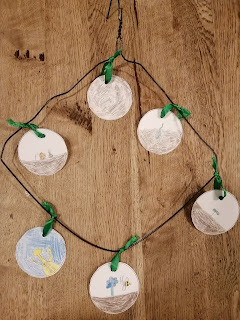Life Cycle Of A Plant Mobile

Life Cycle Of A Plant. We watched the video clip on BBC bitesize on the life cycle of a plant. https://www.bbc.co.uk/bitesize/topics/zgssgk7/articles/zyv3jty Then on white card cut into circles, we drew the 6 stages of the life cycle of the plant. The seed starts to grow shoots and roots in the ground. The seed germinates and the shoot grows and appears above ground. The seedling produces leaves which absorb sunlight in a process called photosynthesis. The flower head grows, makes pollen and attracts bees, this is called pollination. The fertilisation of the flower takes place and tiny seeds are produced. Seed dispersal takes place usually when the flower head dies off. Seeds can be dispersed by the wind, drop to the ground or moved by animals. The process then starts again with the new seeds, the life cycle begins again. We drew the pictures on the front of our cards and wrote what happened on the back. We hole punched the card a...




















